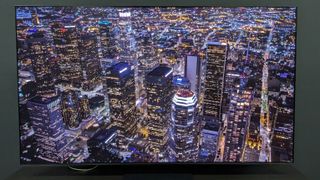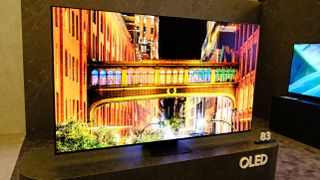- Samsung says its latest QD-OLED panel will hit 4,000 nits
- Based on our previous testing, it is unlikely to hit this number
- LG announces its new panels will hit 3,700 nits too
Samsung Display, which manufactures the QD-OLED panels used by Samsung Electronics and Sony, has said that its latest QD-OLED panel can hit 4,000 nits peak brightness, which would make it the 'brightest OLED panel on the market', as reported by Sammobile.
The new panel, which could be part of Samsung's 2025 QD-OLED TVs such as the flagship Samsung S95F, is said to achieve 30% higher peak brightness than last year's QD-OLED panel, which Samsung Display said could hit 3,000 nits.
This announcement comes at a similar time to reports that LG's latest OLED panels can hit 3,700 nits. Whether these panels will be featured in its 2025 OLED TVs, such as the LG M5 or LG G5, remains to be seen.
While the 4,000 nits number sounds like a breakthrough for OLED TVs, these new QD-OLED panels are actually unlikely to hit 4,000 nits - at least when used in the latest batch of QD-OLED TVs.
Brightness that's too good to be true

In my own testing of last year's Samsung S95D OLED TV, one of the best TVs released in 2024, we measured peak brightness at 1,868 nits and 1688 nits in Standard and Filmmaker picture modes on a 10% white HDR window pattern. This is a ways off the 3,000 nits that Samsung Display claimed this panel would hit.
It's also worth bearing in mind that when claimed peak brightness figures are given by brands, these are usually measured in the brightest picture modes, often called Vivid or Dynamic - a picture mode we here at TechRadar recommend avoiding - and on smaller HDR test pattern window sizes, likely between 2-5%, which won't have as large an effect on HDR highlights as a 10% window, the window size we use to measure peak brightness.
While it didn't hit 3,000 nits, this didn't stop the Samsung S95D winning the title of our TV of the Year and being one of the best OLED TVs ever released. Its peak brightness is still the highest I've tested on an OLED TV, but it'll be some time before an OLED TV can consistently hit 3,000 nits; that's a level usually reserved for the best mini-LED TVs.
So with this in mind, it's extremely unlikely that this year's batch of QD-OLEDs are going to take things a step further and hit 4,000 nits. While a brightness increase in this year's QD-OLED TVs is likely, just how much brighter they'll be remains to be seen.
We've actually seen the S95F in-person and while its new Glare Free 2.0 tech solves the S95D's biggest issue with black levels, we weren't able to test brightness at the time. However, when we can get our hands on one for testing, we'll be sure to give its brightness a thorough test.
TechRadar will be covering all of the latest CES news from the show as it happens. Stick with us for the big stories on everything from 8K TVs and foldable displays to new phones, laptops, smart home gadgets, and the latest in AI.
And don’t forget to follow us on TikTok for the latest from the CES show floor!










 English (US) ·
English (US) ·